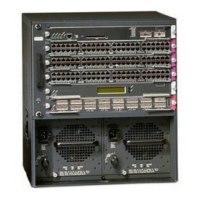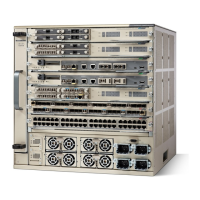8-12
Catalyst 6500 Series Switch and Cisco 7600 Series Router Firewall Services Module Configuration Guide
OL-6392-01
Chapter 8 Configuring IP Addresses, Routing, and DHCP
Configuring OSPF
• To define an area to be a stub area, enter the following command:
FWSM(config-router)# area
area-id
stub [no-summary]
• To assign a specific cost to the default summary route used for the stub area, enter the following
command:
FWSM(config-router)# area
area-id
default-cost
cost
The cost is an integer from 1 to 65535. The default is 1.
This example shows how to configure the OSPF area parameters:
FWSM(config)# router ospf 2
FWSM(config-router)# area 0 authentication
FWSM(config-router)# area 0 authentication message-digest
FWSM(config-router)# area 17 stub
FWSM(config-router)# area 17 default-cost 20
Configuring OSPF NSSA
Single context mode only
Routed firewall mode only
The OSPF implementation of a not-so-stubby-area (NSSA) is similar to an OSPF stub area. NSSA does
not flood type 5 external LSAs from the core into the area, but it can import autonomous system external
routes in a limited way within the area.
NSSA imports type 7 autonomous system external routes within an NSSA area by redistribution. These
type 7 LSAs are translated into type 5 LSAs by NSSA area border routers, which are flooded throughout
the whole routing domain. Summarization and filtering are supported during the translation.
You can simplify administration if you are an Internet service provider (ISP) or a network administrator
that must connect a central site using OSPF to a remote site that is using a different routing protocol
using NSSA.
Before the implementation of NSSA, the connection between the corporate site border router and the
remote router could not be run as an OSPF stub area because routes for the remote site could not be
redistributed into the stub area, and two routing protocols needed to be maintained. A simple protocol
such as RIP was usually run and handled the redistribution. With NSSA, you can extend OSPF to cover
the remote connection by defining the area between the corporate router and the remote router as an
NSSA.
To specify area parameters for your network as needed to configure OSPF NSSA, follow these steps:
Step 1 If you have not already done so, enter the router configuration mode for the OSPF process you want to
configure by entering the following command:
FWSM(config)# router ospf
process_id
Step 2 Enter any of the following commands:
• To define an NSSA area, enter the following command:
FWSM(config-router)# area
area-id
nssa [no-redistribution]
[default-information-originate]
